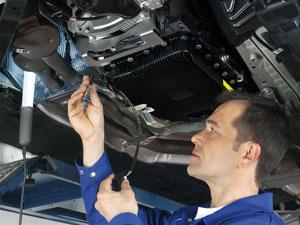|
An oxygen sensor detects the amount of oxygen in the exhaust gas and sends a signal to the engine computer (ECM), which adjusts the air/fuel mixture to the optimal level. Too much oxygen in the exhaust gases indicates a lean mixture, which can cause performance problems, including misfires. Too little oxygen indicates a rich mixture, which wastes fuel and results in excess emissions. Either condition can shorten the life of the expensive catalytic converter. Almost all petrol powered vehicles between 1986 and 1996 have at least one oxygen sensor, whereas newer vehicles often have two or four oxygen sensors. Not only are properly functioning oxygen sensors good for the environment, they can save money in fuel costs, provided they are serviced correctly. An oxygen sensor is a wearing part with a specific service life, not unlike a spark plug. However they are often incorrectly viewed as a repair item. Oxygen sensors will eventually die of “old age” but without regular checking and replacement their performance will greatly deteriorate. The oxygen sensor should have a service life ranging from 50,000km-160,000km dependant on sensor design. Single and two wire sensors should be checked and/or replaced at 50,000km, three or four wire heated sensors at 80,000km, and wide band sensors at 160,000km. There are various conditions however that can dramatically reduce these life spans. Exposure to carbon, dirt, dust, harmful gases, anti-freeze, chemicals, incorrect fuel, water and impact damage will shorten the life of an oxygen sensor. A common practice amongst some engine re-builders and panel beaters is to paint the oxygen sensor and its surrounds, which also causes contamination and “kills” the sensor. Any contamination of the oxygen sensor results in the coating of the platinum electrodes, which insulates them and slows the sensor response time down. This causes the oxygen sensor to give a lower than average reading to the fuel/air mixture, giving the impression that the engine is lean, causing the fuel management system to overcompensate and drift the fuel ratio to rich. The end result of old, worn, damaged or contaminated oxygen sensors, is inevitably the same; higher fuel consumption, poor engine performance and excessive exhaust emissions. Oxygen sensors cannot be cleaned, that is why checking for and replacing a worn out or damaged oxygen sensor is an important part of every routine service. |
Replacing a worn-out oxygen sensor will not only improve a vehicle’s performance and reduce harmful exhaust emissions it can save hundreds of dollars a year in fuel costs. Bosch invented the automotive oxygen sensor. Having manufactured over 400 million oxygen sensors since 1976, today Bosch is the world’s largest producer of oxygen sensors, supplying to virtually all vehicle manufacturers around the world. All Bosch oxygen sensors are manufactured to meet or exceed OEM specifications. Today, Bosch leads the way in oxygen sensor technology and innovation. Bosch oxygen sensors utilise a mix of oxides including zirconium and yttrium to form a tough base that will withstand the intense stress that oxygen sensors are subjected to. Each element is incredibly strong for best-in-class performance and maximum service life. Bosch has a huge range of direct fit oxygen sensors plus a range of universal fit oxygen sensors which cover more than 90% of the Australasian market. |
Servicing Oxygen Sensors
Servicing Oxygen Sensors
Motorsport
Wednesday, 15 April 2009






